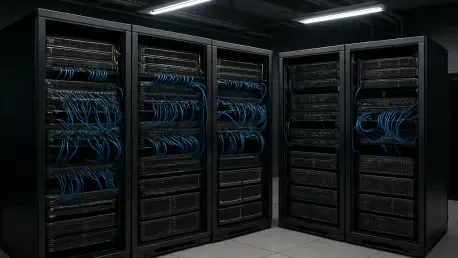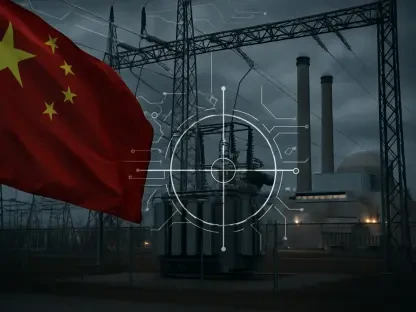Setting the Stage for Grid Innovation
In an era where data centers are the lifeblood of technological progress, the staggering energy demands driven by artificial intelligence (AI) are pushing global power grids to their limits, creating an urgent need for innovative solutions. With data centers in regions like the Pacific Northwest consuming hundreds of megawatts, utilities are grappling with a critical challenge: how to connect these facilities swiftly without compromising grid stability. This market analysis explores the pivotal role AI is playing in revolutionizing grid connectivity for data centers, dissecting current trends, economic implications, and future projections. The focus is on how innovative tools are unlocking capacity and reshaping utility strategies to meet escalating demands, offering critical insights for stakeholders across the energy and technology sectors.
Unpacking Market Trends and Data in Grid Connectivity
Escalating Energy Demands and Grid Constraints
The data center industry is witnessing unprecedented growth, fueled by the computational needs of AI applications, which require constant, high-power loads. In hubs like Hillsboro, Oregon, data centers already account for a significant portion of grid capacity, with some regions supporting loads up to 800 MW on systems handling a total of 4.5 GW. This trend is compounded by active requests for additional gigawatts of power, highlighting a market where traditional grid expansion struggles to keep pace. Utilities face mounting pressure as delays in connections can span years, stalling technological advancements and impacting economic growth in competitive tech markets.
AI as a Game-Changer for Capacity Optimization
AI-driven solutions are emerging as a cornerstone of market innovation, enabling utilities to maximize existing infrastructure rather than relying solely on costly upgrades. Through partnerships with tech startups, utilities are deploying sophisticated algorithms for hourly demand modeling, identifying spare capacity that can be allocated to data centers. For instance, recent initiatives have unlocked over 80 MW of capacity in a single year, allowing facilities to come online much sooner. This shift not only accelerates market entry for data center operators but also sets a new standard for operational efficiency, though challenges remain in ensuring these predictive tools can handle unexpected demand surges.
Economic Value and Strategic Imperatives
The economic ripple effects of AI-enhanced grid flexibility are profound, with each additional megawatt of capacity translating into millions of dollars in value for large data centers—estimates suggest a range of $30 million to $40 million per megawatt. Strategically, this capability is vital for maintaining national competitiveness in technology sectors like AI and semiconductor manufacturing, especially as global rivals ramp up their energy infrastructure. However, the market must address scalability issues, as smaller utilities may lack the resources to adopt such technologies, potentially creating disparities in regional grid capabilities and access to innovation.
Projections for AI in Grid Management
Technological Advancements on the Horizon
Looking forward, the market for AI in grid connectivity is poised for significant evolution, with advancements in battery storage and onsite generation expected to complement existing tools. Emerging algorithms could enable real-time load adjustments, creating a more dynamic and responsive grid system. Projections indicate that between now and 2027, adoption rates for non-wires alternatives may rise substantially if regulatory incentives align with technological progress, potentially reducing connection delays by half in high-demand regions. Such developments promise to reshape how utilities plan for growth in data center energy needs.
Addressing Hyperscale Challenges and Limitations
Despite optimism, the market faces hurdles in addressing hyperscale AI facilities that demand gigawatts of power, far beyond the current scope of flexibility tools designed for loads of 50 MW to 500 MW. Projects requiring massive capacity, such as those in Texas or Louisiana, will likely necessitate hybrid approaches combining AI optimization with targeted infrastructure investments. Market analysis suggests that while AI can facilitate phased load integration, it cannot fully replace the need for physical grid enhancements, pointing to a future where strategic planning must balance innovation with traditional solutions.
Regulatory and Collaborative Opportunities
Future market growth will hinge on regulatory frameworks that encourage the adoption of AI-driven grid solutions. Incentives for non-wires alternatives could spur investment, particularly among mid-sized utilities seeking cost-effective ways to meet demand. Collaborative models between utilities and data center operators are also expected to gain traction, fostering agreements on flexible load profiles that benefit both parties. This trend underscores a broader shift toward partnerships as a key driver of market resilience, ensuring that energy infrastructure keeps pace with digital expansion.
Reflecting on Market Insights and Strategic Pathways
Looking back, this analysis reveals how AI has transformed data center grid connections by unlocking capacity and accelerating integration, addressing immediate market needs while exposing limitations for hyperscale demands. The economic and strategic benefits are substantial, reshaping how utilities and tech industries interact. For stakeholders, the next steps involve investing in hybrid grid strategies that pair AI tools with infrastructure upgrades, ensuring scalability across diverse markets. Additionally, advocating for supportive policies has become essential to lower adoption barriers for smaller players. These actions pave the way for a more adaptive energy landscape, balancing technological growth with sustainable power delivery.









